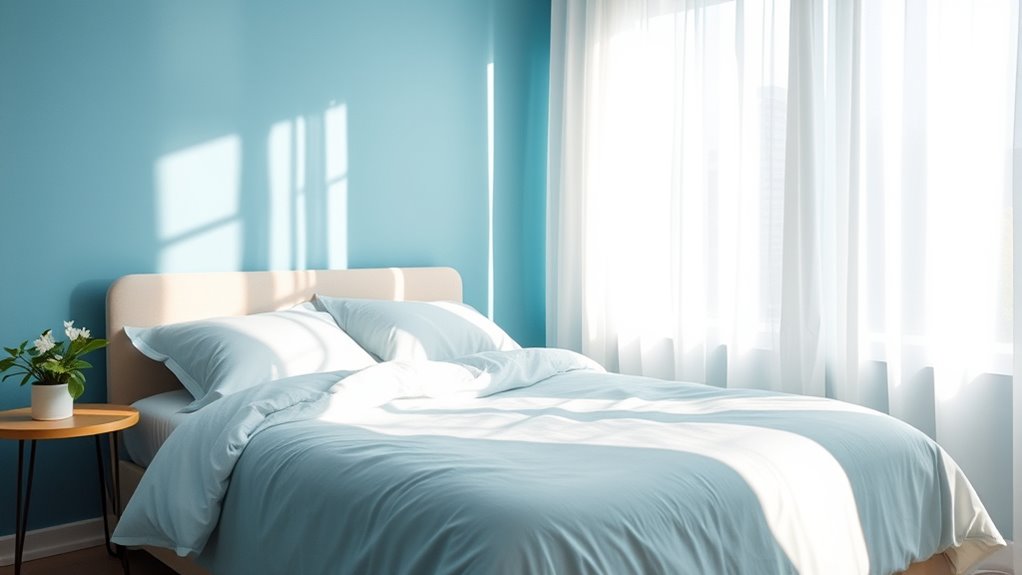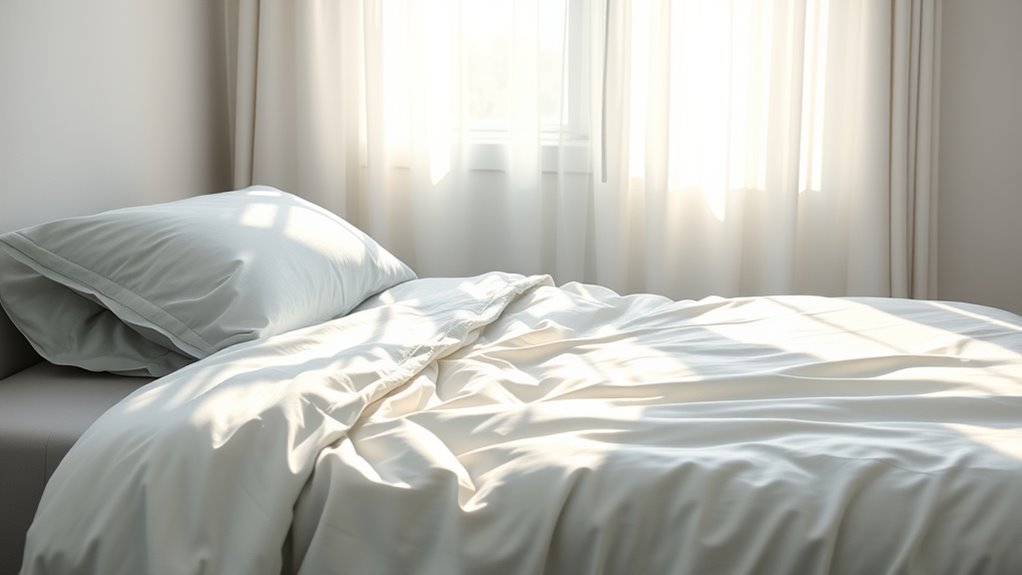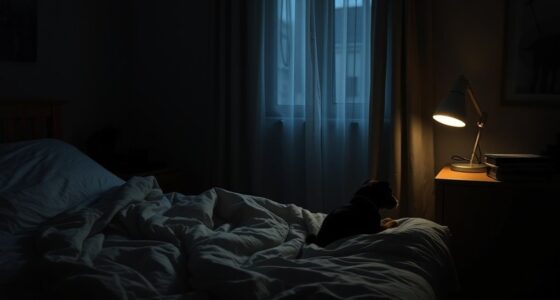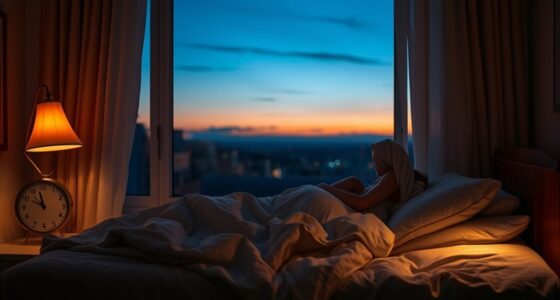Keeping your bedroom cool between 60–67°F helps signal your body to sleep and supports melatonin production, leading to better, deeper rest. During the day, getting plenty of natural sunlight reinforces your circadian rhythm, making it easier to fall asleep at night. Bright days and a cooler room work together to optimize your sleep cycle. To uncover more tips on enhancing your sleep environment, continue exploring how temperature and light shape your rest.
Key Takeaways
- Cooler bedrooms (60–67°F) promote melatonin production, helping you fall asleep faster and achieve restorative sleep stages.
- Bright daytime light reinforces your circadian rhythm, improving sleep quality and wakefulness consistency.
- Darkness in the evening supports melatonin release, while light exposure during the day aids circadian alignment.
- Proper temperature and light management prevent sleep disruptions like restlessness and fragmented sleep.
- Using blackout curtains and natural sunlight exposure optimizes environmental cues for healthier sleep patterns.

Your sleep quality is considerably influenced by the environment around you, particularly temperature and light levels. When your room is too warm or too bright, it can disrupt your body’s natural processes that promote restful sleep. One key aspect affected by these factors is melatonin regulation. Melatonin is a hormone that helps control your sleep-wake cycle, or circadian rhythm. Its production increases in darkness, signaling to your body that it’s time to wind down, and decreases with light exposure, signaling that it’s time to wake up. When your environment isn’t conducive to this natural cycle, your melatonin levels may not rise or fall appropriately, making it harder to fall asleep or stay asleep.
Maintaining a cooler bedroom temperature is essential for supporting your circadian rhythm. Experts recommend setting your bedroom between 60 and 67 degrees Fahrenheit (15.5–19.5°C). A cooler environment helps signal to your body that it’s time to sleep, allowing melatonin production to peak. When your room is too warm, your body struggles to cool down, which can delay melatonin release and prolong the time it takes to fall asleep. Moreover, a warm room can cause restless sleep, frequent awakenings, and lighter sleep stages, leaving you feeling unrefreshed in the morning.
Light levels also play a vital role in regulating your circadian rhythm and melatonin production. During the day, exposure to bright light helps reinforce your natural sleep-wake cycle by suppressing melatonin, keeping you alert and active. As evening approaches, minimizing light—especially blue light from screens—signals to your body that it’s time to prepare for sleep. Bright light exposure late in the day can inhibit melatonin release, delaying sleep onset and disrupting your overall sleep pattern. Conversely, exposure to natural daylight in the morning helps reset your circadian rhythm, ensuring your melatonin production aligns correctly with your sleep schedule. Incorporating light management strategies can further enhance your sleep environment.
Creating a sleep-friendly environment involves both controlling temperature and managing light. Use blackout curtains or sleep masks to block out unwanted light at night. Keep your room cool and dark, and try to get natural sunlight during the day to reinforce your circadian rhythm. Avoid screens at least an hour before bed, or use blue light filters, to prevent light from interfering with melatonin regulation. When these environmental factors align with your body’s natural cycles, you’ll find it easier to fall asleep faster, stay asleep longer, and wake feeling more refreshed.
Frequently Asked Questions
How Does Humidity Impact Sleep Quality?
Humidity impacts your sleep quality by affecting humidity regulation and sleep comfort. High humidity can make your body feel overheated and sticky, disrupting your rest. Low humidity can cause dryness, leading to discomfort and frequent awakenings. Maintaining a balanced humidity level helps you stay comfortable, reduces chances of respiratory issues, and promotes better sleep. You should aim for a humidity level around 40-60% for ideal sleep comfort.
Can Seasonal Changes Affect My Sleep Patterns?
They say, “Change is the only constant,” and seasonal shifts definitely influence your sleep. As seasons change, your mood can fluctuate, and daylight savings disrupts your circadian rhythm. Longer nights may make you feel sleepier, while shorter days can cause insomnia or restlessness. Adjust your sleep schedule gradually and maximize natural light during the day to keep your sleep patterns consistent despite these seasonal changes.
Do Different Light Colors Influence Sleep Differently?
Yes, different light colors do influence your sleep differently. Blue light, with a higher color temperature and intense light, can suppress melatonin production, making it harder to fall asleep. Conversely, warmer colors like red or amber, with lower color temperatures and softer light intensity, promote relaxation and signal your body to prepare for sleep. To improve your sleep, reduce exposure to blue light in the evening and opt for warmer lighting.
How Do Age-Related Changes Affect Sensitivity to Temperature?
You might feel like your body’s thermostat is completely broken, but it’s just age-related thermoregulation kicking in. As you age, your sleep sensitivity to temperature skyrockets, making you more vulnerable to chilly nights or hot flashes. This natural change means even small shifts in room temperature can disrupt your sleep, leaving you exhausted. You need to adjust your environment carefully to combat elderly sleep sensitivity and stay comfortable all night long.
What Are the Long-Term Health Effects of Poor Sleep Environment?
Poor sleep environments can lead to long-term health issues like sleep deprivation and hormonal disruption. When you don’t get enough quality sleep, your immune system weakens, increasing illness risk. Hormonal imbalances may cause weight gain, mood swings, and metabolic problems. Over time, these effects can contribute to chronic conditions such as diabetes, heart disease, and mental health disorders. Prioritizing a comfortable sleep environment helps protect your overall well-being and long-term health.
Conclusion
Think of your sleep as a delicate garden, needing just the right climate to flourish. When your room stays cool and your days are bright, you’re watering the seeds of restful nights. Too hot or too dark, and your garden withers, making sleep harder to find. By tuning into temperature and light, you become the gentle gardener of your own well-being, cultivating peaceful, rejuvenating nights that bloom into brighter days ahead.








